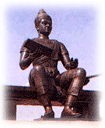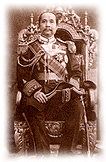            |
 King
Ramkhamhaeng
King
Ramkhamhaeng
|
Thai History
The
origin of the Thai (or Tai) race is shrouded is shrouded in
mystery. One of the convincing hypothesis have been that the
Thai, having migrated form Sichuan province in Central China,
founded a kingdom in southern China called Nanchao, from which
they were driven further south by the all-conquering Mongol
ruler Kublai in 1253, into Indochina and present-day Thailand.
|
|
Sukhothai was the
first independent Thai kingdom. Sukhothai is remembered as
much for its art and architecture as for its political achievements.
During the first half of the 13th century, the Thai rulers
of Sukhothai thrive off the Khmer yoke an set up an independent
Thai Kingdom. King Ramkhamhaeng, was the most famous and dynamic
monarch. The inscription is considered a seminal source of
Sukhothai history as well as a masterpiece of Thai. Suhkothai
was prosperous and well-governed. Its economy was self-sufficient,
small-scale and agricultural. In he time of King Ramkhamhaeng,
this land of Sukhothai is thriving. There are fish in the
water and rice in the fields. ??Sokhothai's decline lasted
from the mid-14th until the 15th century.
For 417 years the kingdoms of Ayutthaya
was the dominated power in the fertile Chao Phraya River Basin.
It is capital was Ayutthaya, which grow into one of Asia's
most renowned metropolises. Ramathibodi I, Ayutthaya 's first
King, was both warrior and a lawmaker. He also expended Ayutthaya's
territory. The paternalistic and benevolent Buddhist kingship
in Sohkothai doesn't work well in Ayutthaya era. Thai society
became strictly hierarchical. There were roughly 3 classes
of people. with the king at the very apex of the structure.
The Ayutthaya period was early Thai history's great era of
international trade. The port of Ayutthaya become an entrepot,
an international marketplace w. Containing merchandise from
all corners of Asia, the thriving markets of Ayutthaya attracted
traders from Europe. The Portuguese were the first to arrive
in 1511. Spain was the next European nation to arrive toward
the end of the 16th century. The early 17th century saw the
arrival of Dutch and British. Then the French came. The foreign
trade grew continuously.
In April 1767, after a 15-month siege, Ayutthaya
finally succumbed to the Burmese, who sacked and burnt the
city, thus putting an end of the most politically glorious
and culturally influential epoch in Thai Society. A half-Chinese
general Phraya Taksin, within a few years this determined
warrior had defeated not only all his rivals but also the
Burmese invaders and had set himself as king. Since Ayutthaya
has been so completely devastated, King Taksin chose to establish
his capital at Thonburi, across the river from Bangkok. Thonburi
was strategically situated near the mouth of the Chao Phraya
River and therefore suitable as a seaport. The rallying of
the Thai nation during a time of crisis was his greatest achievement.
King Taksin's achievements have caused posterity to bestow
on him the epithet "the Great".
The new king, Rama I (1782-1809) was also a great general.
His reign has been called a "reconstruction" of
the Thai State and Thai culture. He was the ruler who established
Bangkok as the capital and was also the founder of the Royal
Hose of Chakri, of which the present monarch. The Grand Palace
and its resplendent royal chapel, the Temple of the Emerald
Buddha were created during his reign.
|
 King
Chulalongkorn
King
Chulalongkorn
|
The
King Rama I's son, Rama II (1809-1824), accepted to the throne
peacefully. His reign was especially notable for the height
attained by Thai poetry. King Rama III had many artistic talents.
Rama III (1824??1851) ruled firmly and with wisdom His half-brother
was accumulating experience which was to prove invaluable
to him during his years as king. The King Rama IV (1851-1865)
was the first chakri king to embark seriously on reform based
on Western models. He concentrated on the technological and
organizational aspect of reform.
|
|
King Chulalongkorn
, Rama V (1868-1910) carried on the reforms and foreign policy
of King Rama IV. He was one of Siam's most loved and reversed
Kings. Indeed, modern Thailand may be said to be a product
of the comprehensive and progressive reforms of his reign.
He was the first Thai king to travel abroad. He put Siam in
a stronger international position. He gradually abolished
both the telegraph service ere introduced and a railway network
was built. Public instruction become more secular than ever
before in Thai history. King Rama V kept Siam an independent
sovereign state overcoming many crises and all the white he
strove to uphold Thai cultural, artistic and religious values.
|
|
|
 King
Bhumibol Adulyadej
King
Bhumibol Adulyadej
|
|
King Rama VI (1910-1932)
was the first Thai King to have been educated abroad. The
major achievement of King Rama VI, however, lay in the area
of education and related legislation. Chulalongkorn University,
Siam's first Western-style university, named in honor of King
Chulalongkorn was established by him. King Rama VII (1925-1935)
, Rama VI's younger brother, to the throne since King VI has
no male heir. He worked hard in addressing himself to Siam's
problems, and his comments on various matters of government
and administration in the state papers of his reign reveal
him to be an admirable ruler in may ways. The 1932 coup d'etat
put an end to absolute monarchy in Siam. A formal constitution
was promulgated and a National Assembly set up. Siam thus
became a constitutional monarchy without any bloodshed or
Wholesale change in its society and economy. King Rama VII
abdicated in March 1935.
|
|
|
Copyright 2001© Ananda Travel Co.,Ltd. All Right Reserved.
|
|







